Tonix Pharmaceuticals Announces Topline Results from Phase 2 PREVAIL Proof-of-Concept Study of TNX-102 SL for the Management of Fibromyalgia-Type Long COVID
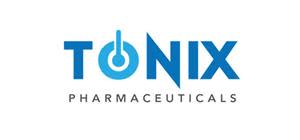

Figure 1.
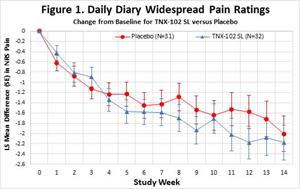

Figure 2.
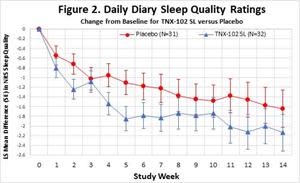

Figure 3.
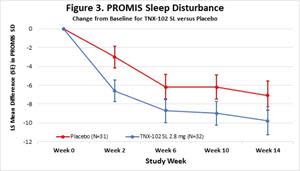

Figure 4.
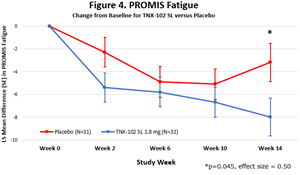

Figure 5.
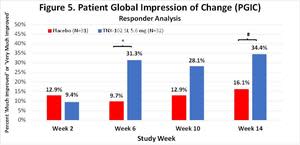

TNX-102 SL showed a robust effect size of 0.5 in improving fatigue and showed consistent activity across secondary measures of sleep quality, cognitive function, disability and Patient Global Impression of Change, but did not meet the primary endpoint of multi-site pain reduction at week 14
Findings fulfill the objectives of this proof-of-concept study, supporting the decision to advance the program based on a proposed primary endpoint using the PROMIS Fatigue scale
Tonix plans to meet with FDA to discuss a path to registration; fatigue is the signature symptom of Long COVID and the principal symptom overlapping with CFS/ME and fibromyalgia syndromes
CHATHAM, N.J., Sept. 05, 2023 (GLOBE NEWSWIRE) -- Tonix Pharmaceuticals Holding Corp. (Nasdaq: TNXP) (Tonix or the Company), a biopharmaceutical company with marketed products and a pipeline of development candidates, today announced topline results from the Phase 2 proof-of-concept PREVAIL study of TNX-102 SL 5.6 mg for the management of fibromyalgia-type Long COVID. TNX-102 SL treatment showed a robust effect size (ES) in improving fatigue and showed consistent activity trending to improvements across the secondary endpoints of sleep quality, cognitive function, disability and patient global impression of change (PGIC). TNX-102 SL trended towards improvement but did not achieve the pre-specified primary endpoint of improving Long COVID pain intensity scores at Week 14. The proposed mechanism of TNX-102 SL is improving sleep quality, which NIH recently announced is a target of future RECOVER clinical trials in Long COVID, a National Institute of Health (NIH) research program designed to understand, treat, and prevent long COVID.1,2 There is currently no approved drug for the treatment of Long COVID.
PREVAIL was a randomized, double-blind, placebo-controlled, multi-site proof-of-concept study of 63 patients with laboratory-documented COVID-19 illness preceding Long COVID. PREVAIL was designed and conducted to guide the design of registrational studies of TNX-102 SL in fibromyalgia-type Long COVID. TNX-102 SL was generally well tolerated with an adverse event (AE) profile comparable to prior studies with TNX-102 SL. AE-related discontinuations were similar in drug and placebo arms. No new safety signals were observed.
“The robust activity of TNX-102 SL on the PROMIS Fatigue scale3-5 (ES=0.5, Figure 4) is important because patients and experts view fatigue as the signature symptom of Long COVID and it has been identified as the dominant symptom contributing to disability,”6 said Dr. Seth Lederman, President and CEO of Tonix Pharmaceuticals. “In addition, TNX-102 SL showed consistent trends toward improvement in sleep quality, cognitive function, disability and the PGIC responder rate for TNX-102 SL compared to placebo (Figure 5) at week 14 (34.4% vs. 16.1%, difference=18.2%). Together, these findings fulfill the objectives of this proof-of-concept study in supporting the decision to advance the program based on a proposed primary endpoint using the PROMIS Fatigue scale.”
The Company intends to request an End-of-Phase 2 meeting with the U.S. Food and Drug Administration (FDA) to discuss a potential Phase 3 program based on a proposed primary outcome measure using the PROMIS Fatigue scale. The meeting is expected to take place in the first quarter of 2024. Fatigue is the symptom of Long COVID that principally overlaps with chronic fatigue syndrome/myalgic encephalomyelitis (CFS/ME) and fibromyalgia. In the NIH funded RECOVER study analysis, fatigue was the top featured symptom and is common in each of the four clusters.7
“The data from PREVAIL reinforce our belief in TNX-102 SL as a potential bedtime medicine for the management of fibromyalgia-type Long COVID,” said Gregory Sullivan, M.D., Chief Medical Officer of Tonix Pharmaceuticals. “We believe the PREVAIL trial results will help guide the next phase of development for TNX-102 SL, supporting the design of a potential registrational trial for fibromyalgia-type Long COVID based on PROMIS fatigue as a primary endpoint, pending review and feedback from the FDA. In both of our prior Phase 3 studies of TNX-102 SL 5.6 mg in fibromyalgia, we observed numerical improvement in the PROMIS fatigue score (in RELIEF p=0.007 MMRM8 and in RALLY p=0.007 MMRM9).”
Dr. Sullivan continued, “Although the validity of PROMIS Fatigue is not yet established in Long COVID, we believe the results of PREVAIL, together with extensive data from studies in other chronic conditions3-5 – including Tonix’s studies in fibromyalgia – make PROMIS Fatigue a solid candidate for the primary endpoint of future Long COVID registrational studies. We look forward to an anticipated End-of-Phase 2 meeting with the FDA to discuss these data and expect to present full data from PREVAIL in a peer-reviewed format and at upcoming medical conferences. Together, we believe these findings support the recognition of fibromyalgia-type Long COVID as a clinically meaningful subgroup of Long COVID patients and underscore the potential of TNX-102 SL as a once daily, oral therapy for this debilitating condition. We are grateful to the patients and their families and supporters, who participated in this study.”
Key Phase 2 PREVAIL Study Results
In the study, 63 subjects were enrolled and randomized 1:1 across approximately 30 U.S. sites to receive either TNX-102 SL or placebo daily at bedtime for 14 weeks. Subjects started with TNX-102 SL 2.8 mg tablet or one placebo tablet for the first 2 weeks and then increased to TNX-102 SL 5.6 mg (2 x 2.8 mg tablets) or two placebo tablets for the remaining 12 weeks of the treatment period. The percentage of subjects completing the study was 81.3% in the TNX-102 SL group and 80.6% in the placebo group. Demographics and baseline characteristics are shown in Table 1.
Table 1: Demographics and Baseline Characteristics |
|
| |
|
|
|
|
Variable | Placebo | TNX-102 SL | Total |
| N=31 | N=32 | N=63 |
Age, mean years (SD) | 51.4 (10.01) | 48.6 (8.80) | 50.0 (9.45) |
Female, number (%) | 25 (80.6%) | 21 (65.6%) | 46 (73.0%) |
Male, number (%) | 6 (19.4%) | 11 (34.4%) | 17 (27.0%) |
Ethnicity |
|
|
|
Hispanic or Latino | 3 (9.7%) | 2 (6.3%) | 5 (7.9%) |
Not Hispanic or Latino | 28 (80.6%) | 30 (93.8%) | 58 (92.1%) |
Race |
|
|
|
American Indian or AN, number (%) | 1 (3.2%) | 0 (0.0%) | 1 (1.6%) |
Asian, number (%) | 0 (0.0%) | 1 (3.1%) | 1 (1.6%) |
Black or African American, number (%) | 5 (16.1%) | 7 (21.9%) | 12 (19.0%) |
Native Hawaiian or PI, number (%) | 0 (0.0%) | 0 (0.0%) | 0 (0.0%) |
White or Caucasian, number (%) | 24 (77.4%) | 21 (65.6%) | 45 (71.4%) |
Multiple Races, number (%) | 1 (3.2%) | 3 (9.4%) | 4 (6.3%) |
BMI, mean kg/m2 (SD) | 29.5 (4.44) | 29.8 (4.07) | 29.6 (4.22) |
Employed, number (%) | 26 (83.9%) | 25 (78.1%) | 51 (81.0%) |
|
|
|
|
Abbreviations: AN, Alaskan Native; BMI, body mass index; PI, Pacific Islander; SD, standard deviation | |||
Primary endpoint
Given the lack of Long COVID treatments and the size of the current proof-of-concept study, an ES ≥ 0.2 was the pre-specified threshold for declaring the primary endpoint positive. The study trended towards a benefit but did not achieve statistical significance on the primary efficacy endpoint of change from baseline in the diary numerical rating scale (NRS) weekly average of daily self-reported worst Long COVID pain intensity scores for TNX-102 SL at the Week 14 endpoint versus placebo (effect size (ES) = 0.08, Figure 1.)
Secondary endpoints
The change from baseline to the Week 14 endpoint for the daily sleep quality diary, PROMIS Sleep Disturbance, PROMIS Fatigue, PROMIS Cognitive function, the Insomnia Severity Index (ISI) and Sheehan Disability Scale showed numerical improvements (MMRM, ES ≥ 0.2): sleep diary (MMRM, ES =0.23, Figure 2.), PROMIS sleep Disturbance (MMRM, ES=0.32, Figure 3.), PROMIS fatigue (MMRM, ES=0.50, Figure 4.), PROMIS Cognitive Function - Abilities, (MMRM, ES=0.21), the ISI (ANCOVA, ES=0.24) and the Sheehan Disability Scale (ANCOVA, ES=0.26). Moreover, robust activity was observed in the PGIC responder (very much improved or much improved) rate for TNX-102 SL compared to placebo (Figure 5): week 6 (31.3% vs. 9.7%, difference=21.6%), week 10 (28.1% vs. 12.9%, difference=15.2%), week 14 (34.4% vs. 16.1%, difference=18.2%).
Safety profile
TNX-102 SL demonstrated a favorable safety and tolerability profile over 14 weeks of treatment with no new safety signals. The most common adverse events are shown in Table 2. Participants with at least one treatment-emergent adverse event (TEAE) were at a rate of 56.3% on TNX-102 SL and 38.7% on placebo. In the TNX-102 SL group, 6.3% discontinued due to TEAE compared to 9.7% on placebo. Only one TEAE in the study was rated as severe, gastritis in a participant in the TNX-102 SL group. There were no serious adverse events (SAEs) in the study.
| Table 2: Adverse Events Occurring in ≥ 2 Participants in Either Treatment Group | |||
|
|
|
|
|
|
| Placebo | TNX-102 SL | Total |
|
| N=31 | N=32 | N=63 |
Administration Site Reactions |
|
|
| |
| Hypoaesthesia oral | 0 | 6 | 6 |
| Product taste abnormal | 0 | 3 | 3 |
| Glossodynia | 0 | 2 | 2 |
| Oral pain | 0 | 2 | 2 |
| Paraesthesia oral | 0 | 2 | 2 |
Systemic Adverse Events |
|
|
| |
| Influenza like illness | 2 | 0 | 2 |
|
|
|
|
|
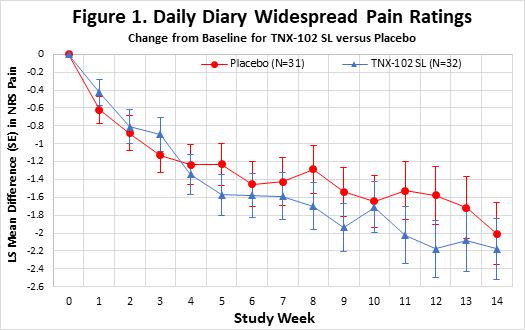
Abbreviations: LS, least squares; SE, standard error
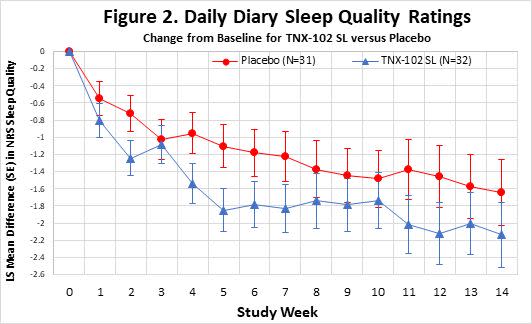
Abbreviations: LS, least squares; SE, standard error

Abbreviations: LS, least squares; SE, standard error; SD, sleep disturbance
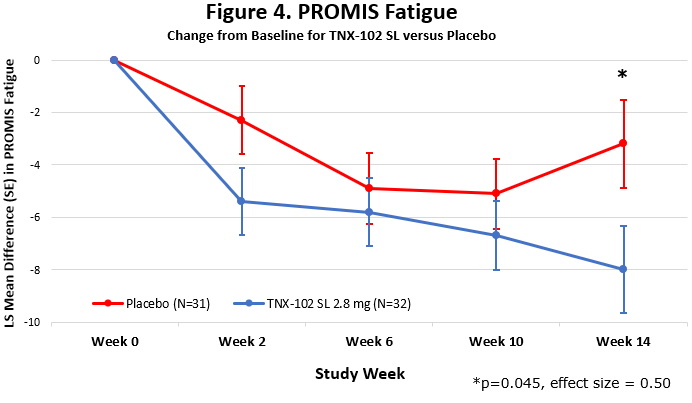
Abbreviations: LS, least squares; SE, standard error

*p=0.034, #p=0.096
About the Phase 2 PREVAIL Study
The Phase 2 PREVAIL proof-of-concept study was a 14-week double-blind, randomized, multicenter, placebo-controlled study to evaluate the efficacy and safety of TNX-102 SL taken daily at bedtime in patients with multi-site pain associated with laboratory-documented post-acute sequelae of SARS-CoV-2 infection (PASC). The trial was conducted at approximately 30 sites in the U.S. The primary efficacy endpoint is the change from baseline in the weekly average of daily self-reported worst pain intensity scores at the Week 14 endpoint. Key secondary efficacy endpoints include change from baseline in self-reported scores for sleep disturbance, fatigue, and cognitive function.
For more information, see ClinicalTrials.gov Identifier: NCT05472090.
About Long COVID or Post-Acute Sequelae of COVID-19 (PASC)
Post-acute sequelae of COVID-19, or PASC is the formal name for a condition now widely known as Long COVID. The U.S. Department of Health and Human Services (HHS) recently estimated that 7.7 million to 23 million Americans have developed Long COVID and announced the formation of the “Office of Long COVID Research and Practice” to lead the Long COVID response and coordinate efforts across the federal government. 10 Although most people recover from COVID-19 within weeks of the acute illness, a substantial portion develops a chronic syndrome called Long COVID.11 These individuals experience a constellation of disabling symptoms long past the time of recovery from acute COVID-19. Most Long COVID patients who have been studied appear to have cleared the SARS-CoV-2 infection from their systems. The symptoms of Long COVID can include fatigue, sleep disorders, multi-site pain, fevers, shortness of breath, cognitive impairment described as “brain fog” or memory disturbance, gastrointestinal symptoms, anxiety, and depression. According to the Centers for Disease Control and Prevention (CDC), 1 in 13 adults in the U.S. (7.5%) have Long COVID symptoms.11 Long COVID is typically associated with moderate or severe COVID-19 but can occur after mild COVID-19 or even after asymptomatic SARS-CoV-2 infection. More than 40% of adults in the United States reported having COVID-19 in the past, and nearly one in five of those (19%) are currently still having symptoms of Long COVID.11 Long COVID is a chronic disabling condition that is expected to result in a significant global health and economic burden.12-15 In response to the urgent need for therapies that address Long COVID, Congress awarded $1.15 billion to the National Institutes of Health to study Long COVID in December 2020.16 The U.S. Department of Health and Human Services National Research Action Plan on Long COVID17, released in August 2022, addresses the overlap of Long COVID with CFS/ME, which, like fibromyalgia, is one of the overlapping chronic pain syndromes with central and peripheral sensitization.18 A published survey19 found comparable pain, fatigue, and functional impairment between Long COVID, fibromyalgia, and CFS/ME. This symptom overlap between these conditions has suggested that altered neurologic function is one of the leading hypotheses to explain them.20 While the vaccines available in the U.S., through either FDA approval or under Emergency Use Authorization, have been shown to prevent acute COVID, their ability to prevent Long COVID is unknown. There is currently no approved drug for the treatment of Long COVID.
About Fibromyalgia-Type Long COVID
Common symptoms of Long COVID, including multi-site pain, fatigue, unrefreshing sleep, and cognitive dysfunction, or ‘brain fog,’ are hallmarks of conditions like fibromyalgia and CFS/ME. Defining subgroups of Long COVID patients that overlap with fibromyalgia and CFS/ME is expected to facilitate the development of new treatments.20 We are studying TNX-102 SL in the subgroup of Long COVID patients whose symptoms overlap with fibromyalgia, which we have termed ‘Fibromyalgia-type Long COVID.’ TNX-102 SL is in phase 3 development for the management of fibromyalgia.8,21 Fibromyalgia has been recognized by the U.S. Food and Drug Administration (FDA) with three approved medicines. The recent identification of Long COVID subgroups in the National Institutes of Allergy and Infectious Diseases (NIAID)-sponsored RECOVER study7 was an important step. In their recent publication7 cluster analysis of the symptom frequencies in the RECOVER study (Researching COVID to Enhance Recovery (RECOVER) research program) identified four subgroups of Long COVID patients. Cluster #4 represented approximately one quarter of the population (28%) and reported the highest frequencies of pain (back pain (58%), joint pain (64%) or muscle pain (60%)), high frequencies of fatigue (94%) and ’Brain Fog,’ (94%) and a high level of impairment of Quality of Life. We believe Cluster #4 is a subgroup of Long COVID that overlaps with fibromyalgia. We also believe that Cluster #3, representing another approximately 29% of the RECOVER cohort, includes many patients with Fibromyalgia-type Long COVID because 100% of that group suffer from ‘Brain Fog’, 94% experience fatigue and approximately one third experience pain (back pain (32%), joint pain (36%) or muscle pain (34%)). Fibromyalgia can result from a variety of different stressors, in addition to infectious illnesses, including hormonal, metabolic, and psychological stressors.23,24 It can be challenging to distinguish fibromyalgia and CFS/ME clinically, given the high level of symptom overlap between them. Each of these conditions is defined by a constellation of symptoms, and there is no widely recognized diagnostic laboratory test that distinguishes them. We presented an analysis of a Fibromyalgia-type Long COVID subgroup from the TriNetX claims database at the BIO-sponsored Long COVID meeting in February 2023.21 That study provided real-world evidence that the majority of Long COVID patients present with a constellation of symptoms that overlap with fibromyalgia and CFS/ME. These symptoms include fatigue, cognitive symptoms, and multi-site pain. Fibromyalgia-type Long COVID, like fibromyalgia and CFS/ME, appears to be both a subgroup of Long COVID and one of several chronic overlapping pain conditions that have in common the neurological process called central and peripheral sensitization, which is increasingly known by the term nociplastic pain.
About TNX-102 SL
TNX-102 SL is a patented sublingual tablet formulation of cyclobenzaprine hydrochloride which provides rapid transmucosal absorption and reduced production of a long half-life active metabolite, norcyclobenzaprine, due to bypass of first-pass hepatic metabolism. As a multifunctional agent with potent binding and antagonist activities at the 5-HT2A-serotonergic, α1-adrenergic, H1-histaminergic, and M1-muscarinic receptors, TNX-102 SL is in development as a daily bedtime treatment for fibromyalgia, Long COVID (formally known as post-acute sequelae of COVID-19 [PASC]), alcohol use disorder and agitation in Alzheimer’s disease. The United States Patent and Trademark Office (USPTO) issued United States Patent No. 9636408 in May 2017, Patent No. 9956188 in May 2018, Patent No. 10117936 in November 2018, Patent No. 10,357,465 in July 2019, and Patent No. 10736859 in August 2020. The Protectic™ protective eutectic and Angstro-Technology™ formulation claimed in the patent are important elements of Tonix’s proprietary TNX-102 SL composition. These patents are expected to provide TNX-102 SL, upon NDA approval, with U.S. market exclusivity until 2034/2035.
*TNX-102 SL is an investigational new drug and is not approved for any indication
Citation:
NIH News Release. July 31, 2023. “NIH launches long COVID clinical trials through the RECOVER Initiative, opening enrollment.” https://www.nih.gov/news-events/news-releases/nih-launches-long-covid-clinical-trials-through-recover-initiative-opening-enrollment (accessed September 4, 2023).
Johnson, M and Goldstein A. Washington Post. July 31, 2023. “NIH announces long covid treatment studies with hundreds of patients” www.washingtonpost.com/health/2023/07/31/long-covid-treatment-studies-nih/
Cook, K.F., et al. 2016Journal of Clinical Epidemiology, 73, 89- 102
Cella, D., et al. 2016Journal of Clinical Epidemiology, 73, 128–134
Lai, J.S., et al. 2011Archives of Physical Medicine and Rehabilitation, 92(10 Supplement), S20-S27.
Walker S, et al. BMJ Open 2023;13:e069217. doi:10.1136/ bmjopen-2022-069217
Thaweethai T, et al. JAMA. 2023. 329(22):1934-1946
Lederman S, et al. Arthritis Care Res. 2023 https://doi.org/10.1002/acr.25142
Sullivan, G et al. Tonix data on file, 2023
NIH Press Release. July 31, 2023. “HHS Announces the Formation of the Office of Long COVID Research and Practice and Launch of Long COVID Clinical Trials Through the RECOVER Initiative” www.hhs.gov/about/news/2023/07/31/hhs-announces-formation-office-long-covid-research-practice-launch-long-covid-clinical-trials-through-recover-initiative.html (accessed September 4, 2023).
NIH News Release. June 22, 2022. “Nearly One in Five American Adults Who Have Had COVID-19 Still Have ‘Long COVID’” https://www.cdc.gov/nchs/pressroom/nchs_press_releases/2022/20220622.htm (accessed September 4, 2023).
Briggs, A, and Vassall, A. Nature. 2021. 593(7860): 502-505
Nittas V, et al. Public Health Rev. 2022. 43:1604501
Davis, HE., et al. EClinicalMedicine. 2021. 38:101019
Martin C, et al. PLoS One. 2021. 16(12):e0260843
The NIH provision of Title III Health and Human Services, Division M--Coronavirus Response and Relief Supplemental Appropriations Act, 2021, of H.R. 133, The Consolidated Appropriations Act of 2021. The bill was enacted into law on 27 December 2020, becoming Public Law 116-260.
Department of Health and Human Services, Office of the Assistant Secretary for Health. 2022. National Research Action Plan on Long COVID, 200 Independence Ave SW, Washington, DC 20201. www.covid.gov/assets/files/National-Research-Action-Plan-on-Long-COVID-08012022.pdf
Maixner W, et al. J Pain. 2016. 17(9 Suppl):T93-T107
Haider S, et al. Pain. 2023. 164(2):385-401
Sutherland, S. Scientific American. 2023
Tonix Pharmaceuticals Press Release. Feb 22, 2023. https://ir.tonixpharma.com/news-events/press-releases/detail/1369/tonix-pharmaceuticals-describes-emerging-research-on-the
Moldofsky H, et al. J Rheumatol. 2011. 38(12):2653-63
Clauw DJ, and Calabrese L. Ann Rheum Dis. 2023
Clauw DJ, et al. Pain. 2020. 161(8):1694-1697
Tonix Pharmaceuticals Holding Corp.*
Tonix is a biopharmaceutical company focused on commercializing, developing, discovering and licensing therapeutics to treat and prevent human disease and alleviate suffering. Tonix Medicines, our commercial subsidiary, markets Zembrace® SymTouch® (sumatriptan injection) 3 mg and Tosymra® (sumatriptan nasal spray) 10 mg under a transition services agreement with Upsher-Smith Laboratories, LLC from whom the products were acquired on June 30, 2023. Zembrace SymTouch and Tosymra are each indicated for the treatment of acute migraine with or without aura in adults. Tonix’s development portfolio is composed of central nervous system (CNS), rare disease, immunology and infectious disease product candidates. Tonix’s CNS development portfolio includes both small molecules and biologics to treat pain, neurologic, psychiatric and addiction conditions. Tonix’s lead development CNS candidate, TNX-102 SL (cyclobenzaprine HCl sublingual tablet), is in mid-Phase 3 development for the management of fibromyalgia, having completed enrollment of a potentially confirmatory Phase 3 study in the third quarter of 2023, with topline data expected in the fourth quarter of 2023. TNX-102 SL is also being developed to treat fibromyalgia-type Long COVID, a chronic post-acute COVID-19 condition. Topline results from a proof-of-concept Phase 2 study were reported in the third quarter of 2023. TNX-601 ER (tianeptine hemioxalate extended-release tablets) is a once-daily oral formulation being developed as a treatment for major depressive disorder (MDD), that completed enrollment in a Phase 2 proof-of-concept study in the third quarter of 2023, with topline results expected in the fourth quarter of 2023. TNX-4300 (estianeptine) is a single isomer version of TNX-601, small molecule oral therapeutic in preclinical development to treat MDD, Alzheimer’s disease and Parkinson’s disease. Relative to tianeptine, estianeptine lacks activity on the µ-opioid receptor while maintaining activity in the rat Novel Object Recognition test in vivo and the ability to activate PPAR-β/δ and neuroplasticity in tissue culture. TNX-1900 (intranasal potentiated oxytocin), is in development for preventing headaches in chronic migraine, and has completed enrollment in a Phase 2 proof-of-concept study with topline data expected in the fourth quarter of 2023. TNX-1900 is also being studied in binge eating disorder, pediatric obesity and social anxiety disorder by academic collaborators under investigator-initiated INDs. TNX-1300 (cocaine esterase) is a biologic designed to treat cocaine intoxication and has been granted Breakthrough Therapy designation by the FDA. A Phase 2 study of TNX-1300 is expected to be initiated in the third quarter of 2023. Tonix’s rare disease development portfolio includes TNX-2900 (intranasal potentiated oxytocin) for the treatment of Prader-Willi syndrome. TNX-2900 has been granted Orphan Drug designation by the FDA. Tonix’s immunology development portfolio includes biologics to address organ transplant rejection, autoimmunity and cancer, including TNX-1500, which is a humanized monoclonal antibody targeting CD40-ligand (CD40L or CD154) being developed for the prevention of allograft rejection and for the treatment of autoimmune diseases. A Phase 1 study of TNX-1500 was initiated in the third quarter of 2023. Tonix’s infectious disease pipeline includes TNX-801, a vaccine in development to prevent smallpox and mpox. TNX-801 also serves as the live virus vaccine platform or recombinant pox vaccine platform for other infectious diseases. The infectious disease development portfolio also includes TNX-3900 and TNX-4000, which are classes of broad-spectrum small molecule oral antivirals.
*Tonix’s product development candidates are investigational new drugs or biologics and have not been approved for any indication.
Zembrace SymTouch and Tosymra are registered trademarks of Tonix Medicines. Intravail is a registered trademark of Aegis Therapeutics, LLC, a wholly owned subsidiary of Neurelis, Inc. All other marks are property of their respective owners.
This press release and further information about Tonix can be found at www.tonixpharma.com.
Forward Looking Statements
Certain statements in this press release are forward-looking within the meaning of the Private Securities Litigation Reform Act of 1995. These statements may be identified by the use of forward-looking words such as “anticipate,” “believe,” “forecast,” “estimate,” “expect,” and “intend,” among others. These forward-looking statements are based on Tonix's current expectations and actual results could differ materially. There are a number of factors that could cause actual events to differ materially from those indicated by such forward-looking statements. These factors include, but are not limited to, risks related to the failure to obtain FDA clearances or approvals and noncompliance with FDA regulations; risks related to the failure to successfully market any of our products; risks related to the timing and progress of clinical development of our product candidates; our need for additional financing; uncertainties of patent protection and litigation; uncertainties of government or third party payor reimbursement; limited research and development efforts and dependence upon third parties; and substantial competition. As with any pharmaceutical under development, there are significant risks in the development, regulatory approval and commercialization of new products. Tonix does not undertake an obligation to update or revise any forward-looking statement. Investors should read the risk factors set forth in the Annual Report on Form 10-K for the year ended December 31, 2022, as filed with the Securities and Exchange Commission (the “SEC”) on March 13, 2023, and periodic reports filed with the SEC on or after the date thereof. All of Tonix's forward-looking statements are expressly qualified by all such risk factors and other cautionary statements. The information set forth herein speaks only as of the date thereof.
Investor Contact
Jessica Morris
Tonix Pharmaceuticals
investor.relations@tonixpharma.com
(862) 904-8182
Peter Vozzo
ICR Westwicke
peter.vozzo@westwicke.com
(443) 213-0505
Media Contact
Ben Shannon
ICR Westwicke
ben.shannon@westwicke.com
(919) 360-3039
Photos accompanying this announcement are available at https://www.globenewswire.com/NewsRoom/AttachmentNg/07482efe-4b16-4cb5-a5d8-1608e1e5412c
https://www.globenewswire.com/NewsRoom/AttachmentNg/e16dda0e-ab4a-44aa-aeb5-919ce14afb84
https://www.globenewswire.com/NewsRoom/AttachmentNg/bbe66a9f-1154-4117-a045-4d07e061660d
https://www.globenewswire.com/NewsRoom/AttachmentNg/18539d75-14de-4e41-800a-5d2ff547f9d3
https://www.globenewswire.com/NewsRoom/AttachmentNg/de06c2b0-02b7-4efa-9f67-ea4ef1429b63

